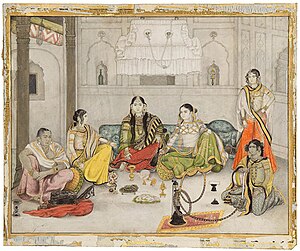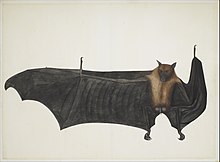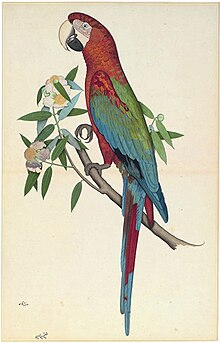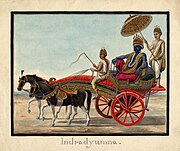
Indian art consists of a variety of art forms, including painting, sculpture, pottery, and textile arts such as woven silk. Geographically, it spans the entire Indian subcontinent, including what is now India, Pakistan, Bangladesh, Sri Lanka, Nepal, Bhutan, and at times eastern Afghanistan. A strong sense of design is characteristic of Indian art and can be observed in its modern and traditional forms.

Mughal painting is a South Asian style of painting on paper confined to miniatures either as book illustrations or as single works to be kept in albums (muraqqa), originating from the territory of the Mughal Empire in the Indian subcontinent. It emerged from Persian miniature painting and developed in the court of the Mughal Empire of the 16th to 18th centuries. Battles, legendary stories, hunting scenes, wildlife, royal life, mythology, as well as other subjects have all been frequently depicted in paintings.

Rajput painting, painting of the regional Hindu courts during the Mughal era, roughly from the end of the 16th century to the middle of the 19th century. Traditionally, Rajput painting is further divided into Rajasthan and Pahari painting which flourished in two different areas "far apart from each other in terms of distance but all under the rule of Rajput chiefs, and bound together by a common culture".

Pahari painting is an umbrella term used for a form of Indian painting, done mostly in miniature forms, originating from the lower Himalayan hill kingdoms of North India and plains of Punjab, during the early 17th to mid 19th century, notably Basohli, Mankot, Nurpur, Chamba, Kangra, Guler, Mandi and Garhwal. Nainsukh was a famous master of the mid-18th century, followed by his family workshop for another two generations. The central theme of Pahari painting is depiction of eternal love of the Hindu deities Radha and Krishna. A distinct lyricism, spontaneous rhythm, softness, minute intricate details of composition, and intense perception and portrayal of human emotions and physical features distinguish the Pahari miniatures from the other miniature schools like Deccan, Mughal and Rajasthani-Rajput.
Munawar Ali Khan was an Indian classical and light classical vocalist of Kasur Patiala Gharana. He was the younger son of Bade Ghulam Ali Khan.

Sir Thomas Theophilus Metcalfe, 4th Baronet, KCB was an East India Company civil servant and agent of the Governor General of India at the imperial court of the Mughal Emperor Bahadur Shah Zafar.
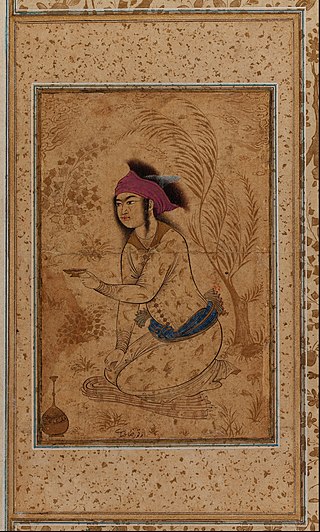
A Muraqqa is an album in book form containing Islamic miniature paintings and specimens of Islamic calligraphy, normally from several different sources, and perhaps other matter. The album was popular among collectors in the Islamic world, and by the later 16th century became the predominant format for miniature painting in the Persian Safavid, Mughal and Ottoman empires, greatly affecting the direction taken by the painting traditions of the Persian miniature, Ottoman miniature and Mughal miniature. The album largely replaced the full-scale illustrated manuscript of classics of Persian poetry, which had been the typical vehicle for the finest miniature painters up to that time. The great cost and delay of commissioning a top-quality example of such a work essentially restricted them to the ruler and a handful of other great figures, who usually had to maintain a whole workshop of calligraphers, artists and other craftsmen, with a librarian to manage the whole process.
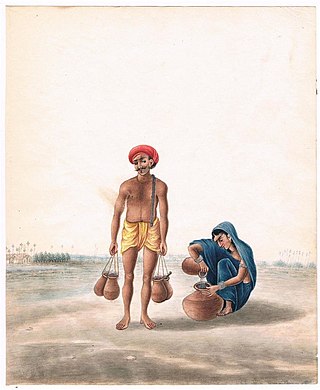
Patna School of Painting is a style of Indian painting which existed in Bihar, India in the 18th and 19th centuries. Patna Qalaam was the world's first independent school of painting which dealt exclusively with the commoner and their lifestyle, which also helped Patna Kalam paintings gain in popularity. The principal centers of this style were in Patna, Danapur and Arrah.

Basāwan, or Basāvan, was an Indian miniature painter in the Mughal style. He was known by his contemporaries as a skilled colorist and keen observer of human nature, and for his use of portraiture in the illustrations of Akbarnama, Mughal Emperor, Akbar's official Biography, which is seen as an innovation in Indian art.

Metcalfe House is the name given to two residential houses built in the 19th century in Delhi; one is near Old Delhi Civil Lines and the other is in Mehrauli, South Delhi. These were built by Sir Thomas Metcalfe (1795–1853), a civil servant, when he was the Governor General's last British resident (agent) at the Mughal court of Emperor Bahadur Shah Zafar.
Ghulam Ali Khan was a nineteenth century Indian painter in Delhi. His painting career took place over the course of more than four decades, from 1817 to 1852. He was the last royal Mughal painter, and also painted in the Company style for British patrons.
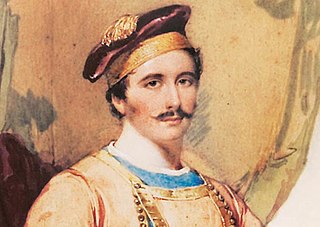
William Fraser was a British India civil servant who was an Agent to the Governor General of India and Commissioner of the Delhi Territory during the reign of the last Mughal Emperor, Bahadur Shah Zafar. He was a brother of James Baillie Fraser.

Delhi Book or Delhie Book titled Reminiscences of Imperial Delhi is a collection of paintings done in Company style, commissioned by Sir Thomas Metcalfe in 1844. It contains 120 paintings by Indian artists, mainly by Mughal painter, Mazhar Ali Khan. The book was bought by the British Library in London.

Mazhar Ali Khan was a late-Mughal era, 19th century painter from Delhi, working in the Company style of post-Mughal painting under Western influence. He was active from 1840, and is known for his noted work of topographical paintings commissioned by Sir Thomas Metcalfe's, Delhi Book.

The Fraser Album is a collection of paintings commissioned by the British Indian civil servant William Fraser. It is considered among the greatest masterpieces of Company painting. This work is an important documentation of the Mughal empire towards its end.
Ghulam Murtaza Khan (1760–1840) is a Mughal era, 19th century painter from Delhi. He worked under penultimate Mughal emperor Akbar Shah II. He worked under British officers, Skinner and William Fraser. The painting style was known as company style.

Guler was a minor kingdom in the Lower Himalayas. Its capital was the town of Haripur Guler, in modern-day Himachal Pradesh. The kingdom was founded in 1415 by Raja Hari Chand, a scion of the ancient royal family of Kangra. The etymology of the word Guler can be traced to the word Gwalior, meaning the abode of cowherds. One of the foremost schools of Pahari miniatures is named after this small principality.
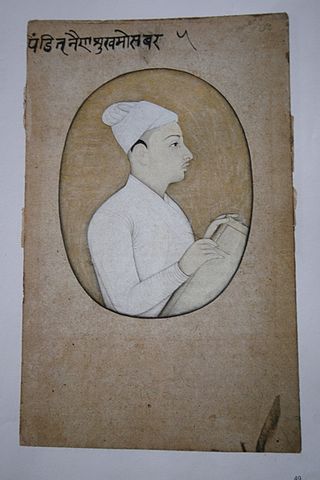
Nainsukh was an Indian painter. He was the younger son of the painter Pandit Seu and, like his older brother Manaku of Guler, was an important practitioner of Pahari painting, and has been called "one of the most original and brilliant of Indian painters".

Deccan painting or Deccani painting is the form of Indian miniature painting produced in the Deccan region of Central India, in the various Muslim capitals of the Deccan sultanates that emerged from the break-up of the Bahmani Sultanate by 1520. These were Bijapur, Golkonda, Ahmadnagar, Bidar, and Berar. The main period was between the late 16th century and the mid-17th, with something of a revival in the mid-18th century, by then centred on Hyderabad.

Indian miniature paintings are a class of paintings originating from India. Made on canvases a few inches in length and width, the Indian miniatures are noted for the amount of details that the artist encapsulates within the minute canvas frame; and the characteristic sensitivity with which the human, divine and natural forms are portrayed.
